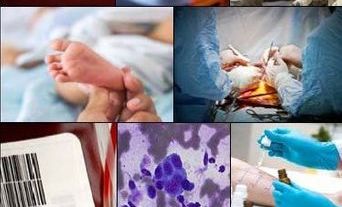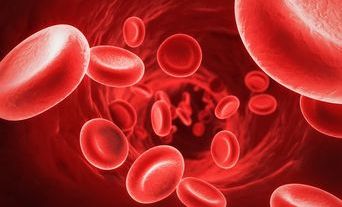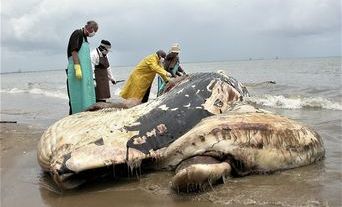Chronic myeloid leukaemia (CML) was once a uniformly fatal disease. However, this illness is now typically a chronic, and even on occasion curable, condition. Many of the seminal moments driving this change are rooted in British medical science.
The history of CML
Early identification of the disease
The first description of CML is traditionally attributed to one or other of Rudolf Virchow or John Hughes-Bennett, who described ‘white blood’ in 1845. Virchow later gave credit for the first description to Hughes-Bennett.
In fact, David Craigie, the physician who looked after two cases of presumed CML in Edinburgh and made the connection that he was observing the same disease, published his findings in the same edition of the Edinburgh Medical and Surgical Journal as Hughes-Bennett, the pathologist who performed the autopsy on the second case.
CML had probably been described earlier in 1825 in France by Velpeau, and in 1839 by Alfred Donne, a distinguished French microscopist under whom Hughes-Bennett had trained.1 Sir Arthur Conan Doyle described the first treatment of CML in 1882, using Fowler’s solution (containing arsenic) to control the white cell count.2
A major breakthrough came in 1960, when Nowell and Hungerford described a minute chromosome in seven cases of the disease known as chronic granulocytic leukaemia.3 In fact, the same abnormality was discovered the same year in Edinburgh, where the first description was generously attributed to their US colleagues, hence the name Philadelphia (Ph+) chromosome.4 Janet Rowley (Chicago) described the reciprocal translocation between chromosomes nine and 22 in 1973.5
Many of the seminal moments driving this change are rooted in British medical science.
Development of treatments
In 1969, John Dacie, Chair of the first UK department of academic haematology at the Royal Postgraduate Medical School (RPMS), hosted the MRC Leukaemia Unit, with David Galton as the first director. Galton conducted the first randomised study in CML, busulphan vs splenic irradiation, where he demonstrated a survival advantage for chemotherapy.6
Busulphan was superseded by hydroxy-carbamide and then by interferon (IFN). The use of IFN (beginning in China) became wide-spread following the work of Moshe Talpaz, who described the partial or complete loss of Ph+ metaphases from bone marrow-derived karyo-types. The CML subgroup of the MRC Working Party published their randomised study of IFN vs busulphan/hydroxycarbamide in 1995, demonstrating a survival advantage for IFN irrespective of cytogenetic response.7
A major breakthrough came in 1960, when Nowell and Hungerford described a minute chromosome in seven cases of the disease known as chronic granulocytic leukaemia...
In 1974, researchers in Seattle reported autologous transplant in advanced phase CML using cryopreserved bone marrow-derived progenitor cells.8 At the RPMS, John Goldman, Ray Lowenthal, Sandy Spiers and David Galton reported circulating progenitor cells in the peripheral blood of newly diagnosed patients with CML. They found the cells could be removed by leukapheresis, cryo-preserved and subsequently used to autograft patients with advanced phase disease.9
In 1987, they described Ph+ negative haemopoiesis after autologous transplant in chronic phase, which became a popular treatment option for patients ineligible for allogeneic transplantation.10
In 1979, Alex Fefer, working with Don Thomas in Seattle, described four successful syngeneic transplants.11 The patients were earlier presented at international meetings, allowing John Goldman to perform the first UK syngeneic transplant for CML at the RPMS in July 1979. This was followed by the first UK allogeneic sibling transplant in 1981, and the first unrelated volunteer donor transplant in 1985, all at the RPMS.
In 1982, Herman Waldmann, Geoff Hale and Mike Clark developed rat monoclonal antibodies capable of lysing human T-cells ex vivo through the recognition of the pan-T-cell marker, CD52, and complement activation. They suggested their use in allogeneic transplants (allo-SCT) to reduce the incidence of graft versus host disease (GvHD).12 Although the technology was highly effective in ameliorating GvHD, it resulted in an increased risk of relapse confirming the existence of the graft versus leukaemia (GvL) effect.13
In 1982, John Groffen, Gerard Grosveld, Nora Heisterkamp, Anne Hagemeijer, Claus Bartram and colleagues reported that the viral oncogene c-abl moved from chromosome 9 to chromosome 22 and subsequently identified the breakpoint regions on chromosome 22.14–16
The following year, Eli Canaani and colleagues described the BCR:ABL1 fusion gene, soon followed by the characterisation of the fusion protein, a dysregulated tyrosine kinase, by the group of David Baltimore.17,18 The final piece of the jigsaw was added by George Daley, Rick van Etten and David Baltimore in 1990, when they reported that aberrant expression of BCR:ABL1 could induce a CML-like disease in mice.19
Current CML outlook
Modern testing and treatments
By this time, CML was the most frequent indication for allo-SCT. In 1990, Hans Kolb (Munich), effectively used infusions of lymphocytes from the original donors (DLI), to treat patients relapsing after transplant,20 a technology further optimised by Steve McKinnon and Francesco Dazzi.21,22
Safety and efficacy were improved by using escalating doses of DLI as early as possible after identification of relapse. This highlighted the need for a sensitive test for disease recurrence and was facilitated by the development by the PCR test by Kary Mullis in 1987.
Work at the RPMS over the next decade – commenced by Gareth Morgan, improved by Tim Hughes and optimised by Nick Cross – resulted in a quantitative reverse transcriptase PCR assay (RT-qPCR) that not only detected BCR:ABL1 transcripts but indicated whether they were decreasing over time as a result of the GvL effect, or increasing and necessitating DLI.23,24
In the 1990s, the BCR:ABL1 protein was crystallised. Elizabeth Buchdunger, Jorg Zimmerdam and Nicholas Lydon at Ciba-Geigy developed phenylaminopyrimidine inhibitors of the Abl kinase domain.25 These were tested against malignant cell lines by Brian Druker, then a clinical fellow at the Dana Faber Cancer Center (Boston), which were found to be selective for cell lines derived from patients with CML.26
The remarkable efficacy of TKI has restored the life expectancy of most patients to that of the normal population.
The impact of tyrosine kinase inhibitors
This led to the rapid development of an orally available drug, STI571, known as a tyrosine kinase inhibitor (TKI), and the start of a series of clinical trials in CML and Ph+ ALL. The Phase I study in advanced phase disease or IFN-resistant chronic phase was presented at the 1999 ASH meeting in New Orleans to a packed room.27
Phase II studies started in early 2000, with strong encouragement from John Goldman (as detailed in Daniel Vasella’s Magic Cancer Bullet: How a Tiny Orange Pill May Rewrite Medical History),28 which led Novartis to pursue licensing of STI571, now known as imatinib (Glivec), in 2001.
In 1998, as Brian Druker was treating the first patients with STI571, Alois Gratwohl, Jane Apperley and European Group for Blood and Marrow Transplantation (EBMT) colleagues published the Gratwohl/EBMT score, which used five pre-transplant parameters (age, disease phase, time from diagnosis to transplant, donor type and sex match of donor and recipient) to predict the outcome of transplants in CML.29 The number of transplants performed annually for CML peaked in 1999 and declined dramatically thereafter as imatinib became clinically available – but long before the demonstration of durable responses.
The results of the Destiny study are the most promising, with almost 70% of patients remaining off-drug, a remarkable achievement for a previously incurable disease.
Further advances in tyrosine kinase treatments
In 2002, Mercedes Gorre, working with Charles Sawyers, found that some patients became imatinib-resistant through point mutations in the kinase domain.30 Since then, almost 100 mutations have been described, resulting in the development of additional TKIs – most recently ponatinib, the only licensed TKI with efficacy against the T351I mutation, and asciminib.
Centres in the UK (Hammersmith & Kings in London, Glasgow, Leeds, Liverpool, Newcastle, Nottingham and Oxford) participated in seminal trials that led to the licensing of all six TKIs. In 2002, Jane Apperley and colleagues demonstrated the efficacy of imatinib against clonal eosinophilic disorders characterised by aberrations of platelet-derived growth factor receptor (PDGFR) and PDGRF beta.31
UK colleagues were represented in the European LeukemiaNet (ELN) international consensus group’s highly cited guidelines for CML management (2006, 2009, 2013, 2020).32 Notable UK contributions include: John Goldman and Nick Cross’s efforts to establish an international scale for reporting RT-qPCR results; Junia Melo identifying other mechanisms for TKI-resistance; the Hammersmith’s observations of the importance of early molecular responses; the impact of non-compliance and biomarkers of prognosis at diagnosis; Hugues de Lavallade’s development of next generation sequencing for mutation detection; and Jane Apperley’s work in defining safe practice for parenting.
During her post-doc in Vancouver with Alan and Connie Eaves, Tessa Holyoake discovered that more than 50% of single primitive stem cells out of cycle were Ph+ and returned to Glasgow to explore ways of targeting leukaemic stem cells.33 Imatinib sensitive, patient-derived CD34+ cells were stimulated to proliferate and differentiate. The addition of imatinib eradicated dividing cells, leaving only the quiescent fraction.
Mhairi Copland reported similar results using the second generation TKI, dasatinib. Holyoake, Copland, David Vetrie and Tony Whetton took a systems neology approach to identify novel approaches to eradicate CML stem cells, culminating in the identification of EZH2, and the combination of upregulation of p53 and down-regulation of c-Myc as potential therapeutic strategies.34
The remarkable efficacy of TKI has restored the life expectancy of most patients to that of the normal population. Long-term clinical trial outcomes report 10-year survival rates greater than 80% with the most common cause of death being unrelated to CML. Many groups have studied treatment discontinuation and found that up to 50% of patients with deep and durable responses to TKI can cease treatment indefinitely.
In 2019, Richard Clark, on behalf of the National Cancer Research Institute's CML subgroup, published a conceptually unique study in which patients with deep molecular responses were first de-escalated to 50% of the standard dose for 12 months before stopping their TKI. The results of the Destiny study are the most promising, with almost 70% of patients remaining off-drug,35 a remarkable achievement for a previously incurable disease.
Acknowledgements
The authors acknowledge the support of the National Institute of Health Research (NIHR) Imperial Biomedical Research Centre.
Disclosures
Jane Apperley has research funding from Incyte and Pfizer, is in the Speakers Bureau and is an Advisory Board Member for Incyte and Novartis.





